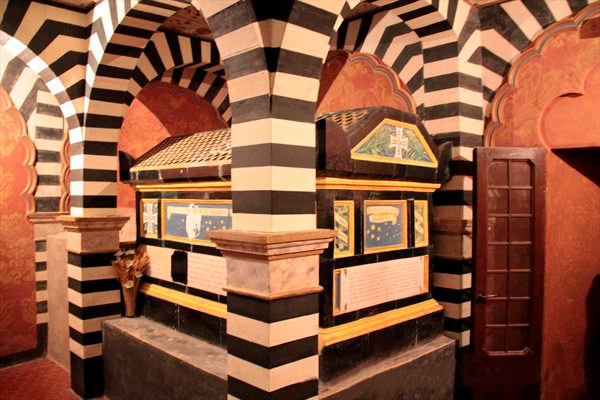
Nestled between the Apennines' green mountains in Bologna is one of the world's most unusual and bizarre castles, Rocchetta Mattei, a fortress characterized by an eclectic style rife with symbolism.
Rocchetta Mattei is a mix of medieval, gothic, and middle-eastern styles with onion-shaped domes, minarets, cylindrical and square towers, and turrets unique to Emilia-Romagna. The orders of count Cesare Mattei built this castle as the central place to his practice of homeopathic medicine. Construction of the castle began in 1850 on a hill located in Savignano and was already habitable by 1859.

Count Cesare Mattei was a very well known intellectual, self-taught doctor, politician, but more importantly, as a founder of electro-homeopathy, which was the commonly used alternative medicine between 1870 and 1930. Electrohomoeopathy is a derivative of homeopathy, which, according to Mattei, was an effective cancer treatment that uses no surgery.
Mattei became so popular around the world that he was even mentioned by Dostoeveskji in his novel The Brothers Karamazov, and visited by some of the most illustrious figures of the time including Ludwig III of Bavaria and Alexander II of Russia.
Rocchetta Mattei underwent several modifications during Count Mattei's life, turning it into a maze of towers with grand staircases, private rooms, and reception rooms inspired by different styles, including medieval, Moorish, gothic, and Art Nouveau.
Read also: Lebron James Under Contract to Buy LA Mansion, Miley Cyrus Purchases Hidden Hills Home Off-Market
Among the many courtyards, rooms, and passages, the not to be missed attractions of Roccheta Mattei include:
Cortile dei Leoni or Courtyard of Lions is a reproduction of the Courtyard of Alhambra in Spain's Granada
Cappella or the Chapel is a reproduction of the interior Cathedral of Cordova in Spain and its Moorish style.
Sala dei Novanta or Room of the 90, a large room built to host Mattei's celebration on his 90th birthday, where 90 guests aged 90 were expected to attend. Mattei, unfortunately, died before reaching the age of 90.

After Mattei died in 1896, Mario Venturoli Mattei, his adopted son, finished the castle and continued producing and distributing the remedies until the manufacturing laboratories were closed in 1959.
Mattei's heir, Iris Boriani, attempted to sell the building but was unable to do so and donate it to Bologna's Municipality, but the offer was refused. Ultimately, Rocchetta Mattei was sold to Primo Stefanelli, who converted one of the buildings into a hotel. Stefanelli wanted to rehabilitate the building, which was damaged during World War II, and turns into a tourist destination but did not live to see his dream for the castle come true.
After Stefanelli's death, Rocchetta Mattei fell into disrepair and was permanently closed to the public. The Carisbo Foundation acquired Roccheta Mattei in 2005 and had it restored. In 2015, the castle was again opened to the public for guided visits.
© 2025 Realty Today All rights reserved. Do not reproduce without permission.



